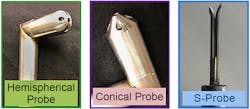In collaboration with industry, researchers at the National Institute of Standards and Technology (NIST) have completed the first real-world test of a new to measure smokestack emissions in coal-fired power plants. Each year, coal-fired plants must have their smokestacks emissions audited or checked by an independent third party, according to EPA regulations. NIST researchers wanted to make this test quicker to save the plants money during their audits, while also improving accuracy of the sensors. So, a NIST team has designed new probes for sensing emission flow rates and a new measurement method that could potentially speed up on-site audits by a factor of 10, researchers say.
The fieldwork results were “promising,” says NIST engineer Aaron Johnson, and were in reasonable agreement with the laboratory findings. “We were surprised; it did quite well compared to what the EPA has on its books as its ‘best practices’ method.”
To monitor emissions from coal-fired power plants, technicians must measure the rate at which flue gas flows up the smokestack. The flow inside the smokestack contains eddies and swirls but generally travels up.
NIST’s Joey Boyd (left) and Aaron Johnson test the new sensors at a power plant. The platform, which gives them access to the smokestack, is about 144-ft above the ground.
In the NIST tests, four probes, or pitot tubes, were inserted horizontally into the smokestack. The four probes each measure flow measurement at four different spots, for a total of 16 measurements. With this information, NIST engineers could test the precision and accuracy of a new pitot tube design and measurement method.
NIST conducted this work as part of a cooperative research and development agreement (CRADA) with the Electric Power Research Institute (EPRI), an independent nonprofit organization whose members include electric utility companies, businesses and government agencies.
“Coal-fired electric generating units may benefit from this work by having improved standards and techniques to measure mass emissions more accurately, with increased confidence that all entities are reporting on a uniform basis,” says EPRI program manager Tom Martz. He added that the potential time savings “is not something we can accurately quantify at this time, but it will be a key objective of future work.”
The ultimate goal is to provide research the EPA might someday develop into a new standard for smokestack emissions calibration.
“The advantages for industry are that it will reduce test time and cost and could be more accurate than current industry-standard probes,” Johnson says.
Even if the EPA does not create a new standard, however, the work could benefit industry by providing power plant companies with more choices for managing emissions tests. “Our goal is to get it written as an EPA standard,” Johnson says. “But it’s still up to industry members to decide whether they would want to use it.”
Smokestacks at coal-fired power plants are equipped with monitors that continuously measure the concentration of flue gas emissions, which include carbon dioxide, mercury, sulfur dioxide, and nitrogen oxides, as well as the flue gas’ flow rate. By federal law, the built-in flow-rate sensors need to be calibrated, that is, checked for accuracy during the annual audit.
NIST designed two pitot probes (left and center), one with a cone-shaped sensing surface, and the other’s hemispherical. The probes have five holes, or ports. Comparing pressure readings obtained in each of the five ports lets technicians calculate the flow rate. An older type of pitot tube, the S-probe (right), has two ports that face in opposite directions.
To conduct the yearly calibration, the audit technicians climb the stack, usually hundreds of feet high, and insert pitot probes horizontally into the gases churning their way up the smokestack. They take several readings of the flow at various points within a cross-section of the stack, which is typically about 25 ft in diameter.
By far the most common kind of sensor used for this work is an “S-probe.” It has two holes, or ports. One port faces directly into the flow of gas and detects pressure that builds up in the tube. The other port faces the opposite direction. The faster the flow, the greater the pressure difference between the two ports; measuring this difference in pressure lets auditors calculate the flow’s speed.
S-probes don’t require calibration, but each measurement can take several minutes, because technicians must manually rotate the sensor until one side faces directly into the flow. This is complicated by the fact that the flow doesn’t necessarily travel straight up at the point being tested. At the base of the stack, flue gas usually travels around a sharp bend, which creates complex eddies and swirls that don’t go away even in tall smokestacks.
Using S-probes is so labor-intensive that an on-site annual calibration can take a day or more to complete. “And the power plant is losing money all the time the auditors are there, so they want the technicians in and out as fast as possible,” Johnson says.
To speed up this process, NIST scientists have made three innovations. First, they created two new models of pitot tubes, with five holes instead of two, which perform better than S-probes and may offer advantages over other five-hole models of pitot tubes currently in use. The probes, designed by NIST physicist Iosif Shinder, come in two shapes: hemispherical and conical.
Second, the scientists have developed a calibration scheme for their new sensors that does not require a technician to rotate the probe inside a smokestack to find the true direction of the flow for each measurement. So, although the sensors would have to be calibrated before use, they would take much less time to use during actual audits.
Third, NIST’s Jim Filla developed software that is compatible with a commercially available automated system to measure flow in real time.
Until now, the new probes’ performance had been measured only at NIST’s test facility, which includes a scale-model smokestack simulator and a wind tunnel. But NIST’s laboratories cannot replicate all aspects of a real power plant, such as the presence of soot in the smokestack’s flow.
“It’s one thing to test it in our wind tunnel,” Johnson explans. “It’s another to prepare to test it in a stack that’s 120°F.”
The first field run, in July of last year, took place at a natural gas plant, where flow is relatively straightforward to measure. The second, in Sept. 2018, was conducted at a coal-fired power plant with a particularly complicated flow.
The coal-fired plant had an enclosed platform where the pitot tubes were inserted into the smokestack. But the natural gas plant’s platform was open to the elements. And at roughly 145 ft in the air, “things shake,” says NIST technician Joey Boyd. “While you’re working, the stack is swaying, and the floor beneath you is moving.”
When NIST researchers analyzed the data, their results were promising, agreeing to within 2% to their laboratory findings.
“The probes performed equally well in the smokestack as they did at NIST’s test facility,” Johnson says.
Future field tests will help the researchers solve the biggest problem they had: sensor clogging, in which the pitot tubes’ ports get gummed up with water and particulate matter and have to be flushed before a test can continue.
Also, the work taught them they needed to write special software signaling to their equipment every time there was a “purge,” a high-pressure blast of air through the pitot probe that could damage a key part of the apparatus if certain valves were not closed in time.
Click here for a video detailing the process.



